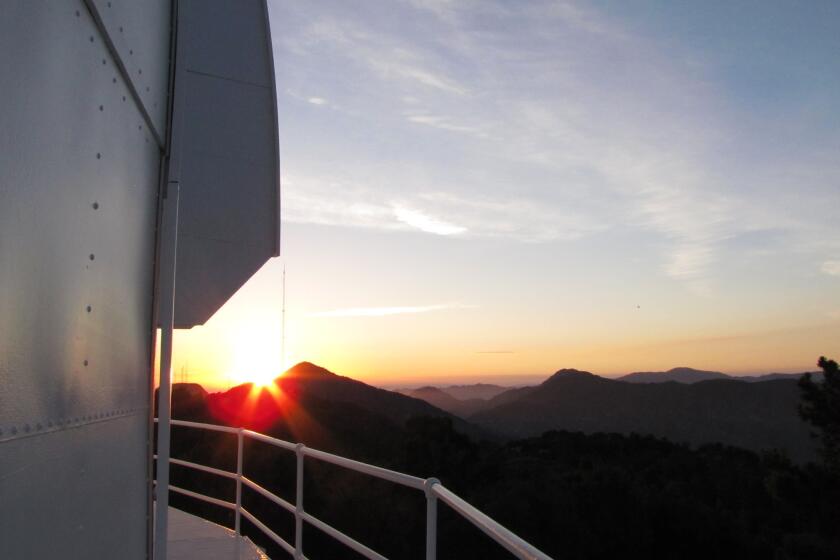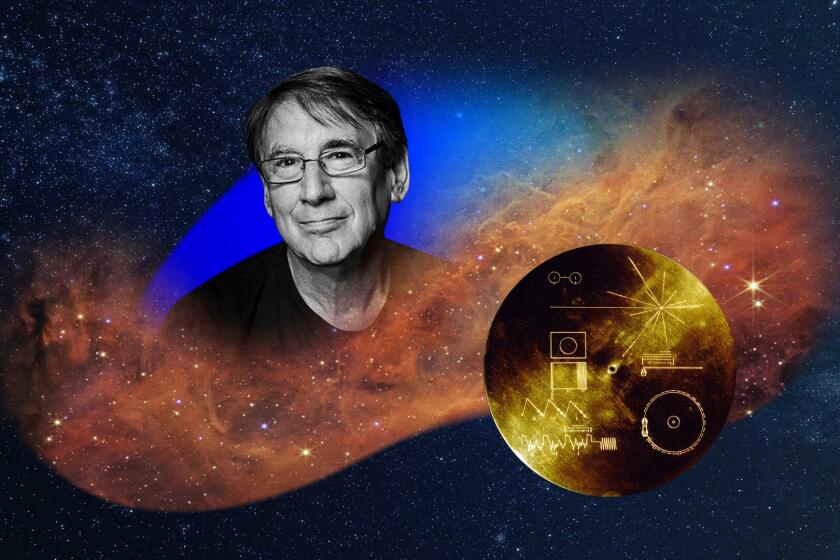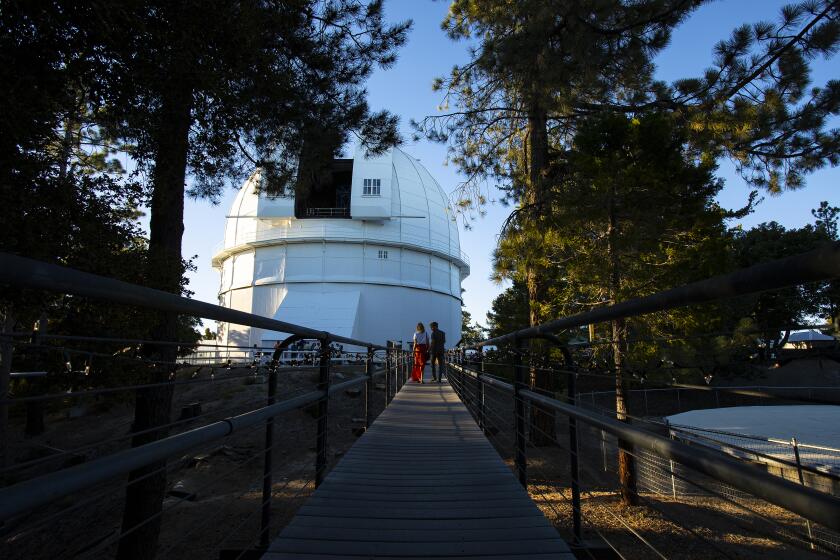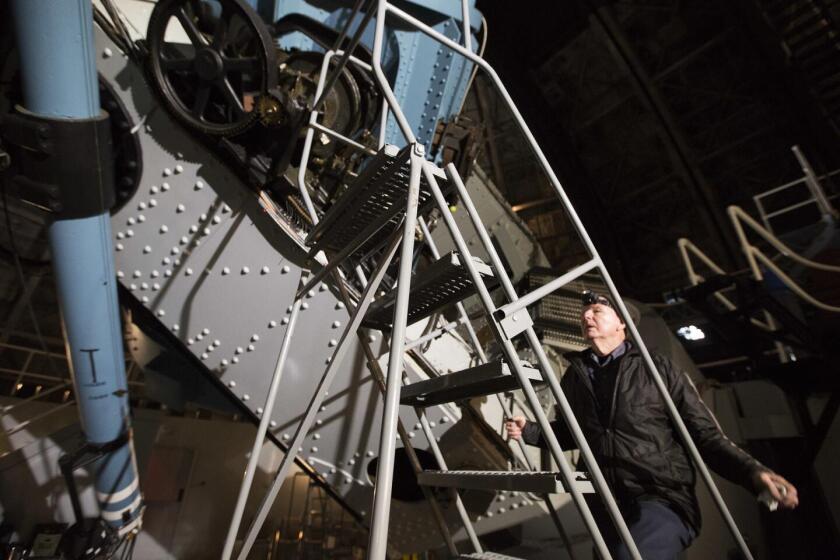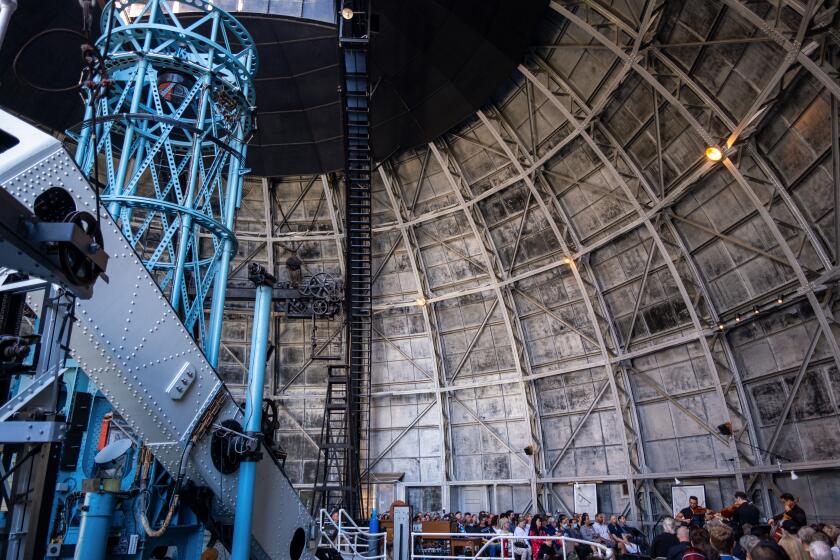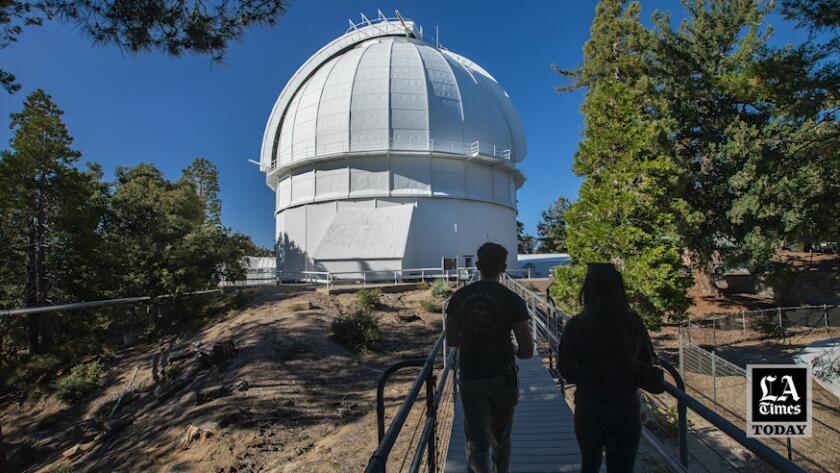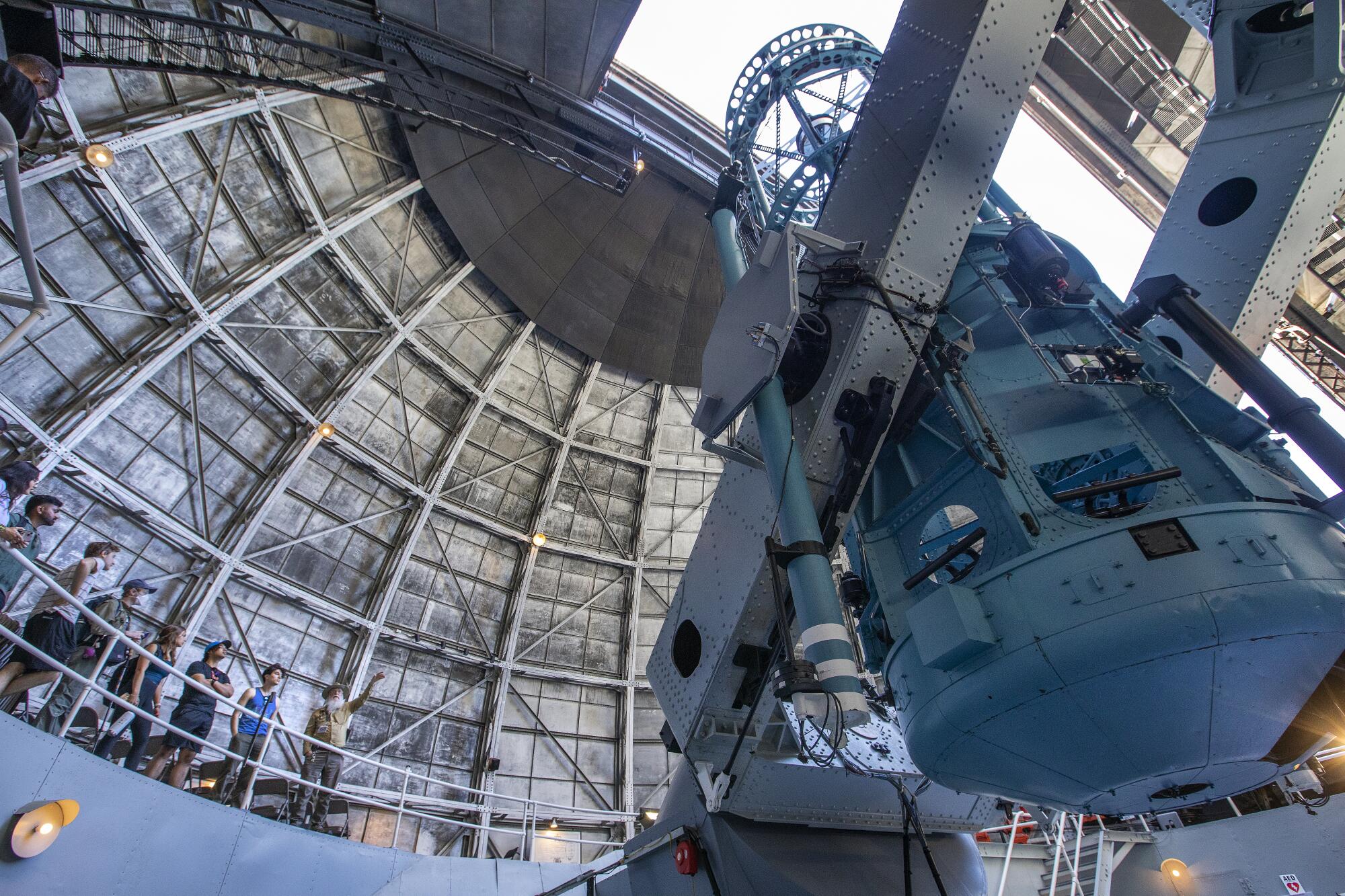
- Share via
Los Angeles was once the best place in the world to see the universe.
The most important things we know about the cosmos were discovered in the early 20th century at Mt. Wilson Observatory. It was here, 100 years ago, that Edwin Hubble noted a light in the distance that would lead to one of science’s greatest discoveries.
By night, astronomers kept watch at the best telescopes on Earth. But by day, a city grew between the mountain and the sea. The lights of Los Angeles multiplied with each passing year until their glow obscured that of the stars above.
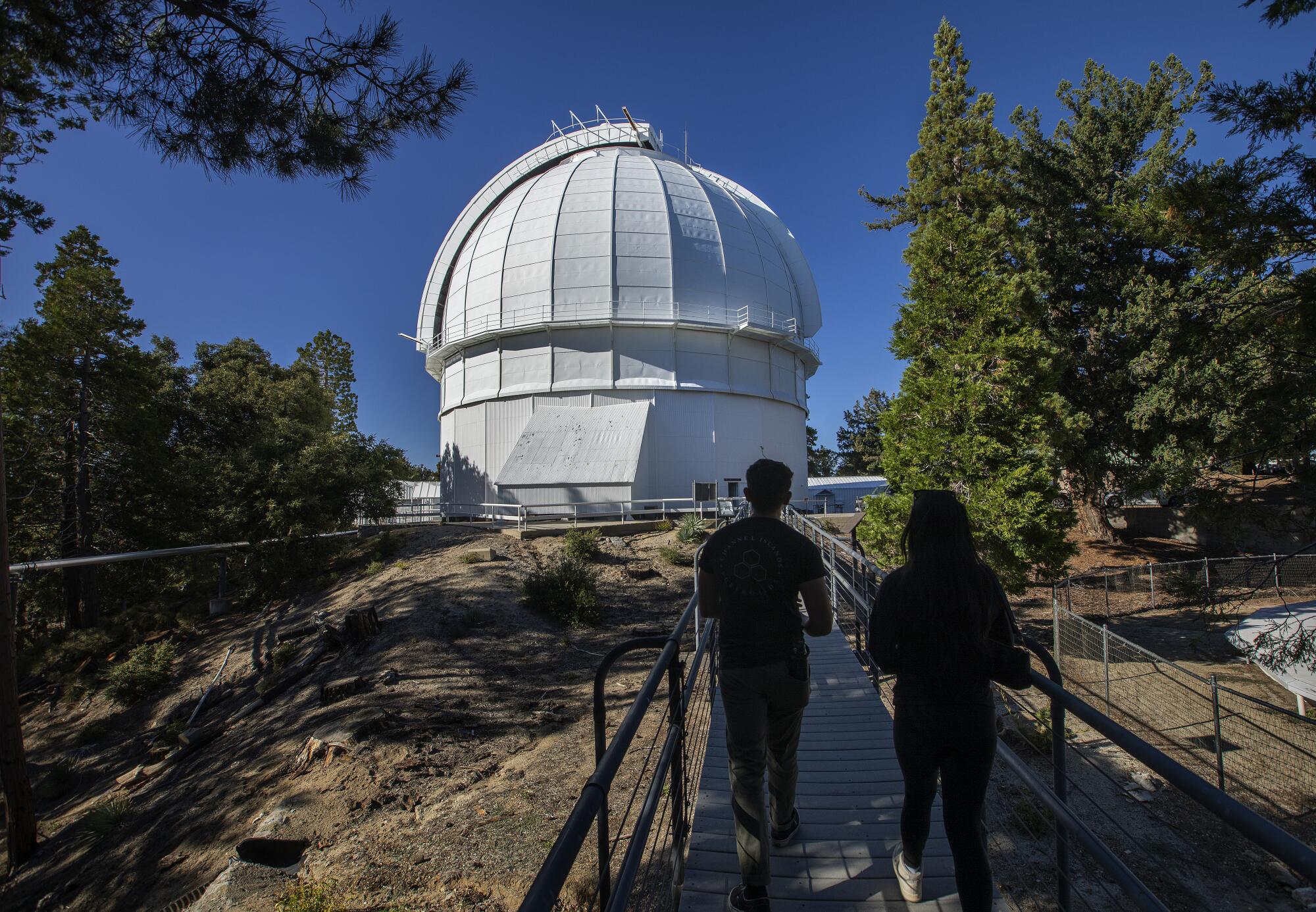
Astronomers moved on to clearer skies, beneath which larger and more powerful telescopes would be built. And Mt. Wilson Observatory discovered what so many aging luminaries in L.A. have: Once your starlight fades, no one is quite sure what to do with you.
With an annual budget smaller than that of some fancy L.A. parties, a nonprofit organization and volunteers have done a heroic job of keeping the grounds and telescopes open for visitors and the few scientists still working there.
But as the 100th anniversary of Mt. Wilson’s greatest discovery approaches this week, those most dedicated to the historic and scientific treasure could use a breakthrough of their own.

The observatory sits at the summit of 5,715-foot Mt. Wilson, accessible only by a serpentine stretch of Angeles Crest Highway.
When George Ellery Hale established it in 1904 with funding from what is now Carnegie Science, building a mountaintop telescope demanded a new level of ambition. Mules and mule-driven carts hauled hundreds of tons of material up the 18-mile road, which wasn’t paved until 1907.
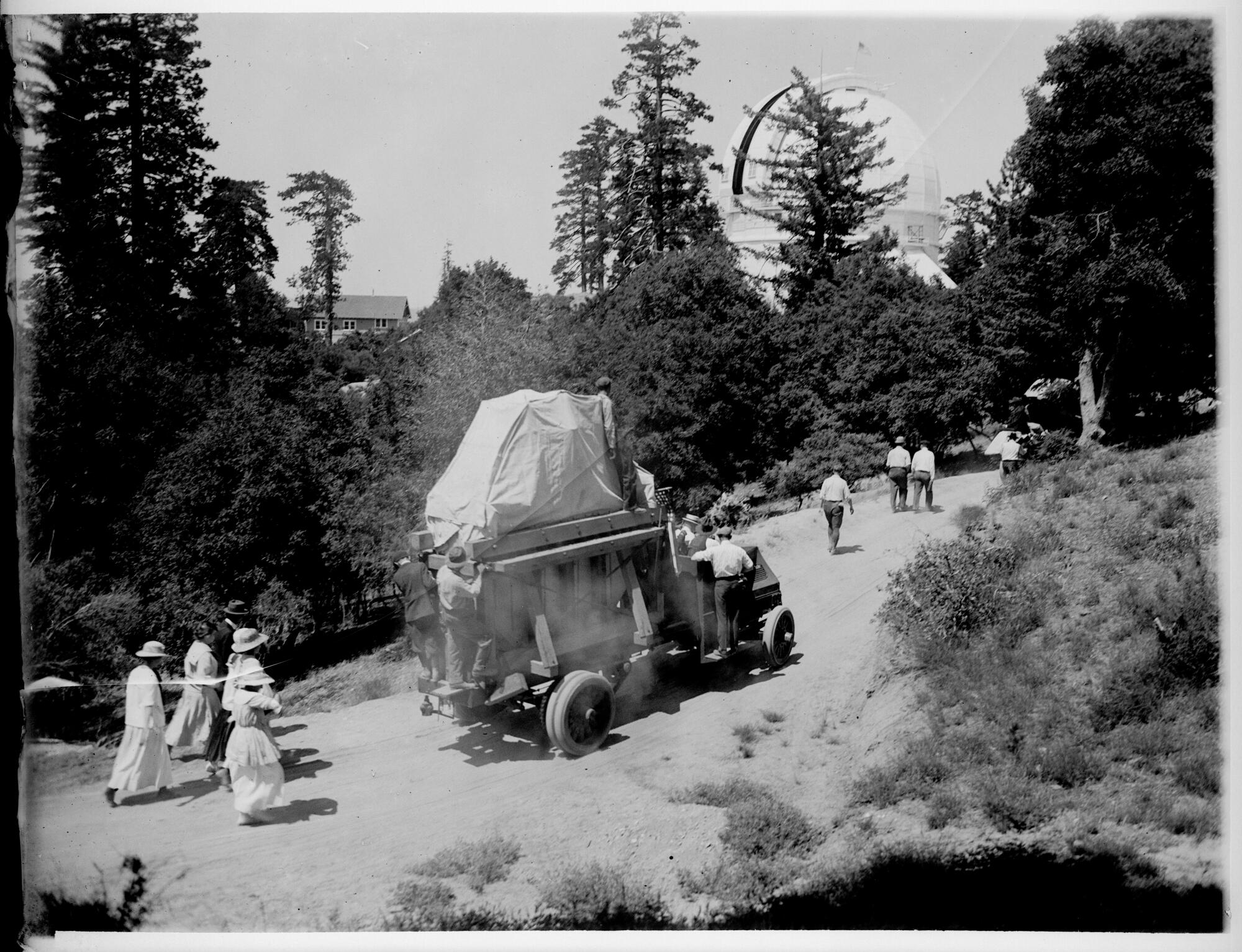
In 1908 the animals delivered a 60-inch wide, 1,900-pound mirror to collect light from the stars — the keystone of the largest and most powerful instrument of its kind in the world. The mirror wasn’t even installed before Hale began planning for a 100-inch telescope that would gather three times as much light.
“His philosophy was to go to the best possible place, where the air was steady and the skies were dark ... build the cutting-edge instruments like had never been built before, and hire the very best people he could to use them,” said Hal McAlister, professor emeritus of astronomy at Georgia State University and a former executive director of the Mt. Wilson Institute, the barely funded nonprofit that now manages the observatory. “He achieved all three.”
The first thing I notice as we climb the steep stairs is an old hand crank telephone — the kind that looks like a face with two brass bells for eyes and a black trumpet for a mouth.
Among those hires was Edwin Hubble, who arrived at the observatory as a staff astronomer in 1919.
The kind of temperament that can tolerate long nights alone with the stars often has a lot of room for quirks. Hubble was no different.
He attended Oxford University as a Rhodes Scholar and came home with an affected British accent he turned on and off for the rest of his life. Though he told friends and biographers he practiced law before turning to astronomy, he was in fact a high school teacher who never handled a case. But though he sometimes played loose with the facts of his life, he was famously disciplined about the stars.
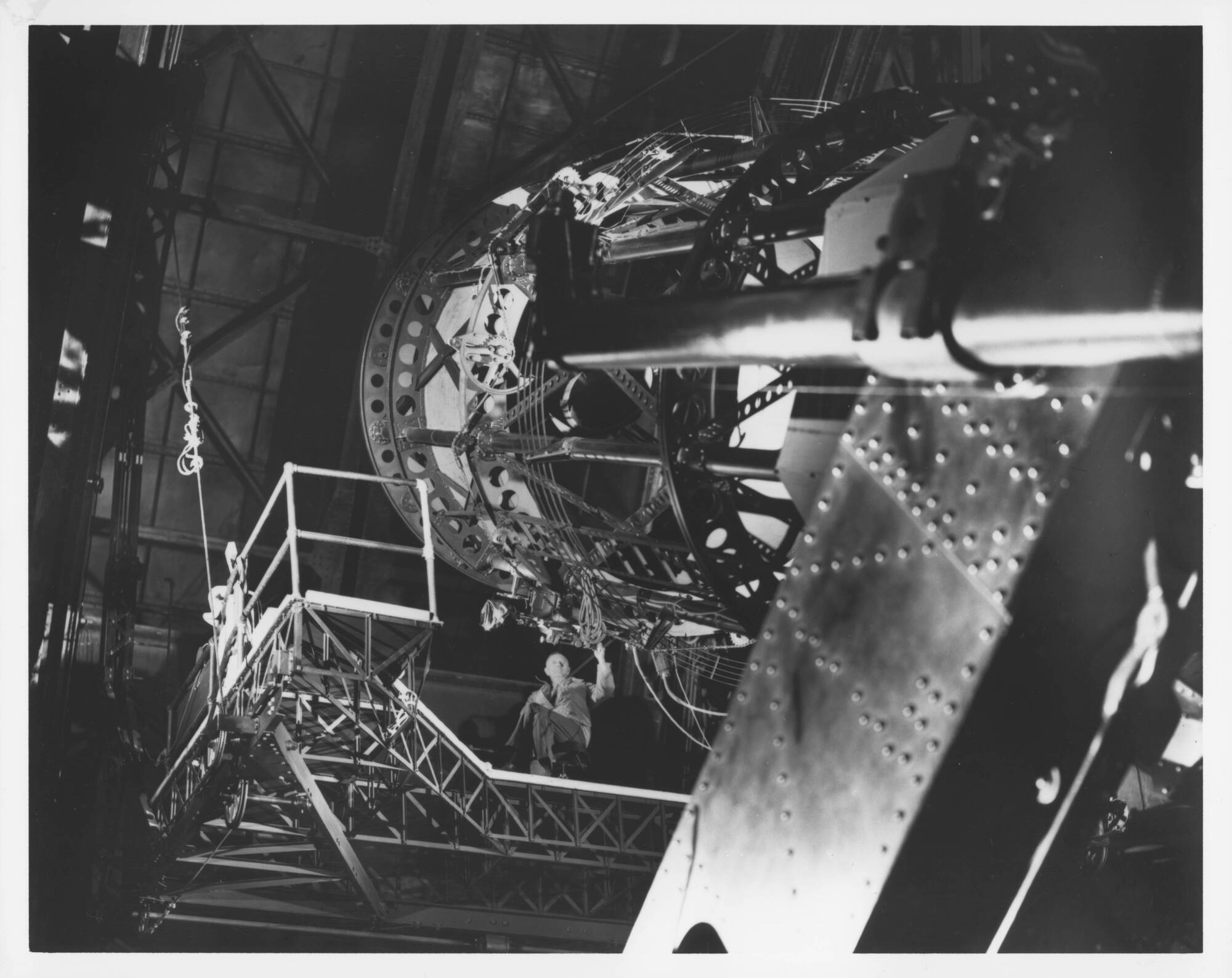
On the night of Oct. 5, 1923, Hubble pointed the 100-inch telescope toward M31, a blob of faint light then known as the Andromeda nebula.
The human eye only collects up to 0.2 seconds of visual data before uploading it to the brain. A camera can collect light over a much longer period, which is why long-exposure photographs of the night sky contain far more stars than are visible with the naked eye. Hubble set the telescope’s camera to capture a photograph with a 45-minute exposure and developed the result onto a glass plate.
For the record:
9:05 a.m. Oct. 3, 2023An earlier version of this story said Edwin Hubble used the label “N” on a photographic plate to mean nebula. It stood for nova.
Over the following weeks, as Hubble peered closely at the image, he noticed three distinct points of light in the fuzzy cloud of stars, rather than the single one he expected to see. He marked each with an N, for nova.
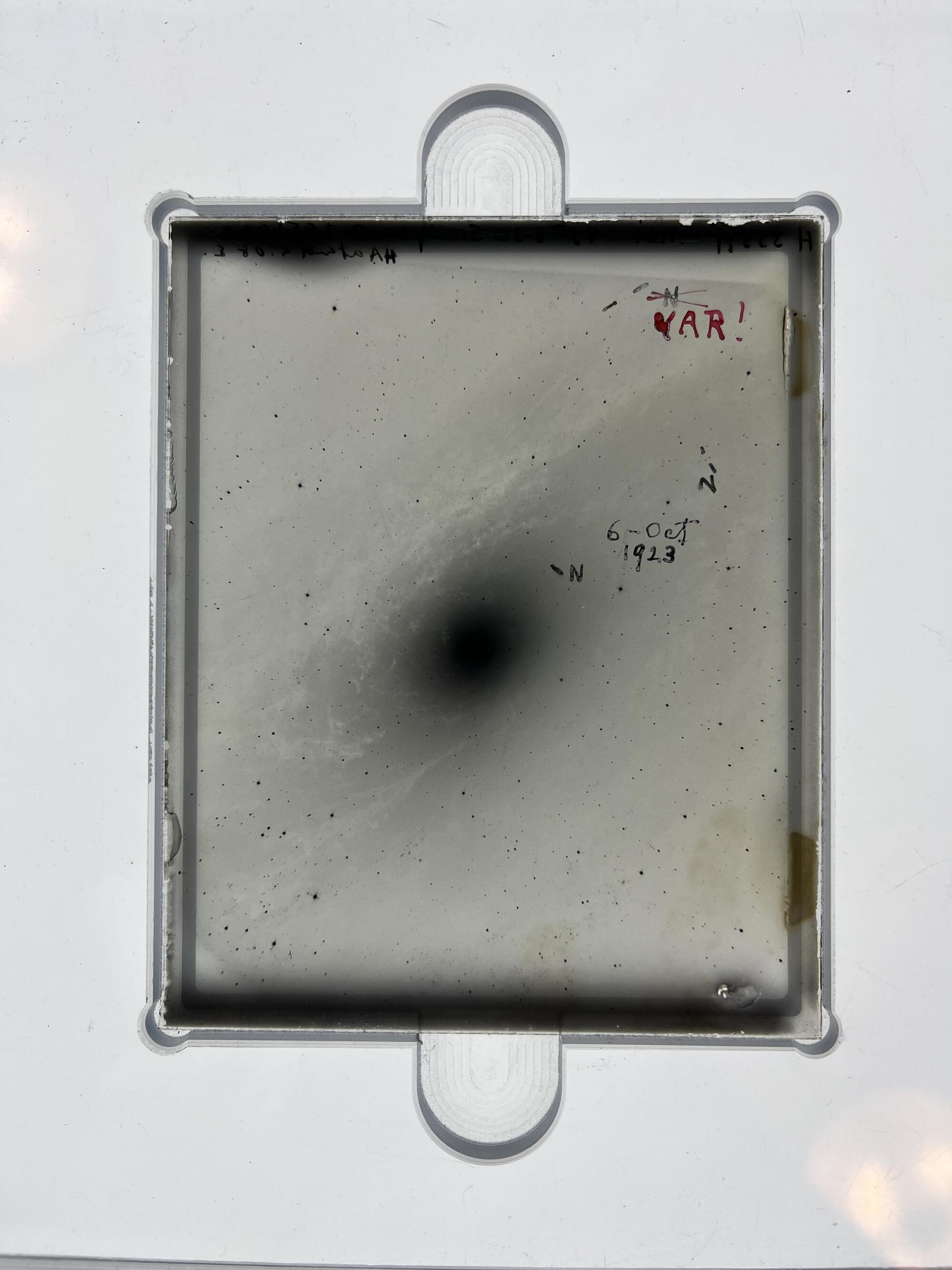
He started going through other plates in the Carnegie Observatories archives in Pasadena to figure out what those extra points of light might be. As he pored through the carefully labeled images, he realized that one light grew brighter and dimmer in regular intervals over the months.
It was a Cepheid variable, a type of star beloved by astronomers because its luminosity and pulse length can be used to measure its distance from Earth. At this, even the reticent Hubble allowed himself to celebrate. He went back to the plate, crossed out an N and wrote “VAR!” in capital letters.
Energized by the finding, Hubble carried out the calculations and realized the Cepheid had led him to an even greater discovery. The star was farther away than anything in the Milky Way — too far, in fact, to still be considered part of it.
Andromeda was not another star in our galaxy, but a galaxy all its own. In a flash of light, the universe had become an infinitely vaster and more interesting place.

Nearly 100 years later, Tom Meneghini, executive director of the Mt. Wilson Institute, stepped expertly among the vintage scientific equipment scattered around the ground floor of the great telescope, reaching into shadows to flick on light switches he knew were there.
“All this you see here — all this steel, all this concrete — came up by mule,” he said, gesturing to the thick latticework supporting the upper floors and the pile of old telescope track wheels rusting in the corner.
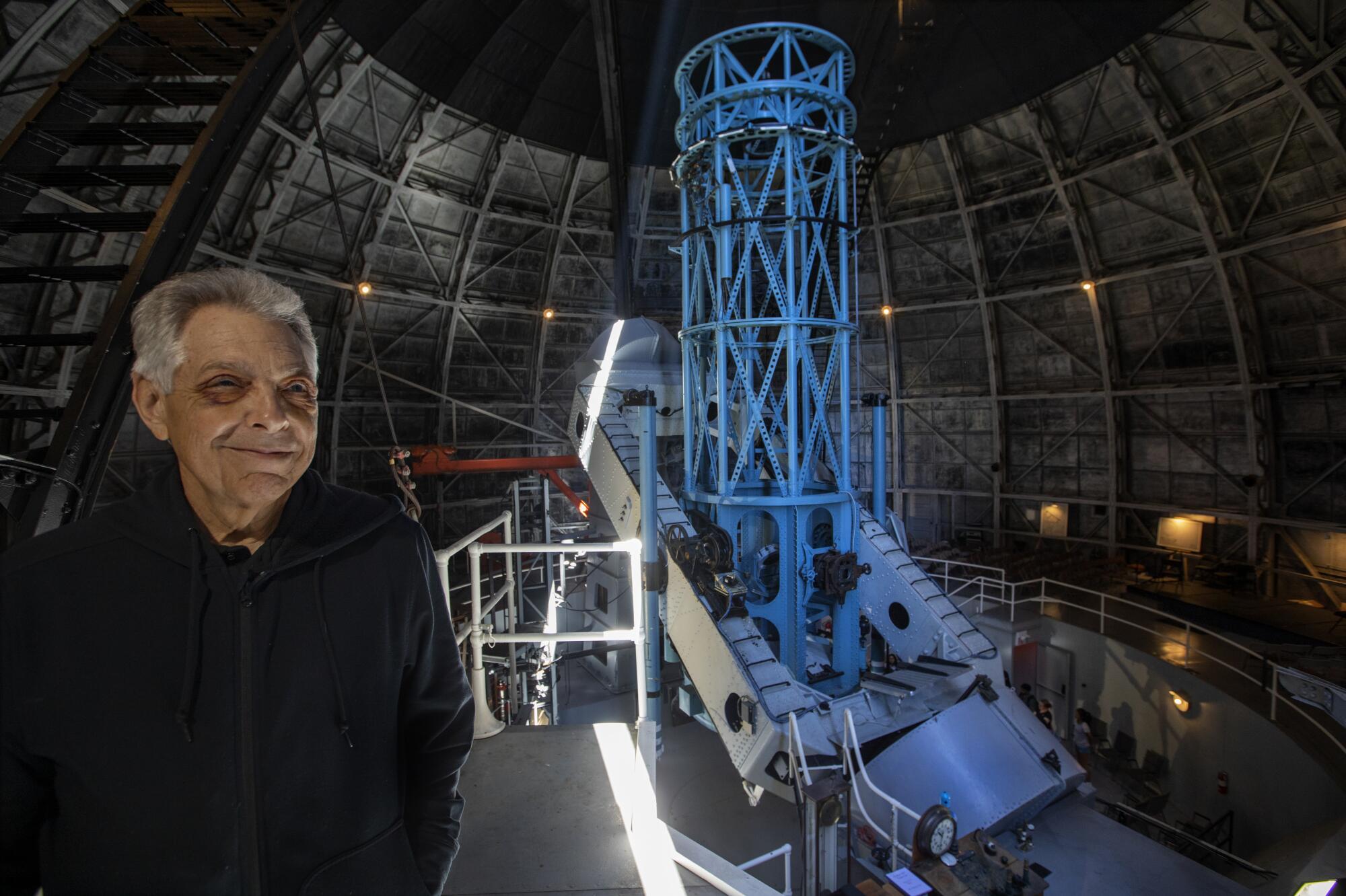
A lifelong astronomy enthusiast, Meneghini began volunteering as a Mt. Wilson telescope operator in 2002. He took over management of the institute in 2014 after retiring from Star Harbor Federal Credit Union.
He was visiting Mt. Wilson with John Mulchaey, director of the Carnegie Observatories.
“This is where the magic happened,” Mulchaey said, looking admiringly into the rafters of the massive dome.
The office for Carnegie Observatories still occupies its original space in Pasadena, a 1912 building with a book-lined library, a large portrait of Hale and a photograph of Albert Einstein posing next to the same portrait of Hale in the same book-lined library.
The VAR! plate lives there, as do 250,000 others taken over the years at Mt. Wilson. Among other records, the archives contain a copy of Hubble’s logbook from the fall of 1923. His handwriting in the Oct. 5 entry is unusually cramped and urgent, the Hubble equivalent of unrestrained glee.
Space artist Jon Lomberg has produced work that attempts to visualize what we can’t truly see, and to communicate with creatures we can’t yet imagine.
Hubble remained on staff at Mt. Wilson until his death in 1953 from a blood clot in the brain. Yet even in his heyday, he could tell that the swiftly multiplying lights at the foot of the mountain would spell trouble for stargazers.
In 1934, when Hale was looking for a place to install his 200-inch mirror telescope, he chose Palomar Mountain in San Diego County for its darker skies. In 1969, Carnegie opened Las Campanas Observatory in Chile’s Atacama Desert, replete with a 100-inch reflecting telescope of its own.
Aggressive and impactful reporting on climate change, the environment, health and science.
Despite its august place in scientific history, Mt. Wilson was no longer the best place on Earth to do astronomy. Carnegie pulled its funding from the observatory and closed the big telescope in June 1985.
“Our mission of course is science,” Mulchaey said. “Since we’re not really doing science research here at the moment, Mt. Wilson can’t be a priority for us.”
The future of Carnegie’s astronomy program is at Las Campanas, where the institution is building the Giant Magellan Telescope. The $2.5-billion instrument will be up to 200 times more powerful than any ground-based telescope, with 15 times the light-collecting area of the James Webb Space Telescope.
“That’s where our resources have gone,” Mulchaey said.
Talk about star power. Mt. Wilson has an amazing history. Up here, astronomers first measured the Milky Way and discovered the universe was expanding. Go see the distant stars for yourself and expand your universe as well.
UCLA took over Mt. Wilson’s solar telescopes with a grant from NASA. Georgia State’s Center for High Angular Resolution Astronomy Array broke ground in 1996 on a sextet of optical interferometric telescopes known as the CHARA Array, the largest of its kind in the world. (None of these instruments study objects affected by urban light pollution.)
It’s been nearly 40 years since Carnegie Science ran out of money to keep its original observatory open. They also couldn’t afford to close it.
Carnegie’s agreement with the U.S. Forest Service stipulates that the observatory must remain an active site for research, astronomy or education — or be dismantled down to its last historic bolt.
No one had the desire — or the cash — to demolish the place, as the terms of the Forest Service lease would have demanded had Carnegie just locked the gates and walked away.
But without constant maintenance, everyone knew the mountain and its elements would make quick work of Hale’s famous telescopes.
Eight months after Carnegie’s retreat, a constellation of former employees, scientists and observatory fans incorporated the Mt. Wilson Institute. Four years later, Carnegie signed over management of the observatory.
“You don’t just throw away a historic place like that,” McAlister said.
You don’t just throw away a historic place like that.
— Hal McAlister, former executive director of the Mt. Wilson Institute

Today, the Mt. Wilson Institute has three full-time paid employees, all maintenance workers and groundskeepers. Two paid part-timers manage projects. Everything else is done by an unusually skilled corps of volunteers.
Volunteers built modern digital tracking and driving systems to steer the 60- and 100-inch telescopes. They lubricate the telescopes and operate them on public viewing nights. They maintain century-old electrical wiring and repair machinery erected when Woodrow Wilson was president.
There seems to be a near-inexhaustible supply of them. In a way, this is thanks to Hale too: He helped establish Caltech, whose researchers in turn founded the Jet Propulsion Laboratory. Many volunteers are veterans of one or both.
“We put out a call for a volunteer engineer, and we get 10,” Meneghini said. “We’re running on a lot of free labor.”
Dressed in parkas and knit caps, the three volunteers lug crates of power tools and spooled wire into the gleaming mountaintop edifice that some have called astronomy’s “Sistine Chapel” and immediately start tinkering.
The institute’s annual budget is between $800,000 and $1 million, less than 10% of the cost to maintain and improve the nearby Rose Bowl. Nearly all of the institute’s income comes from ticketed events such as public viewing nights and monthly concerts, all of which are volunteer-run.
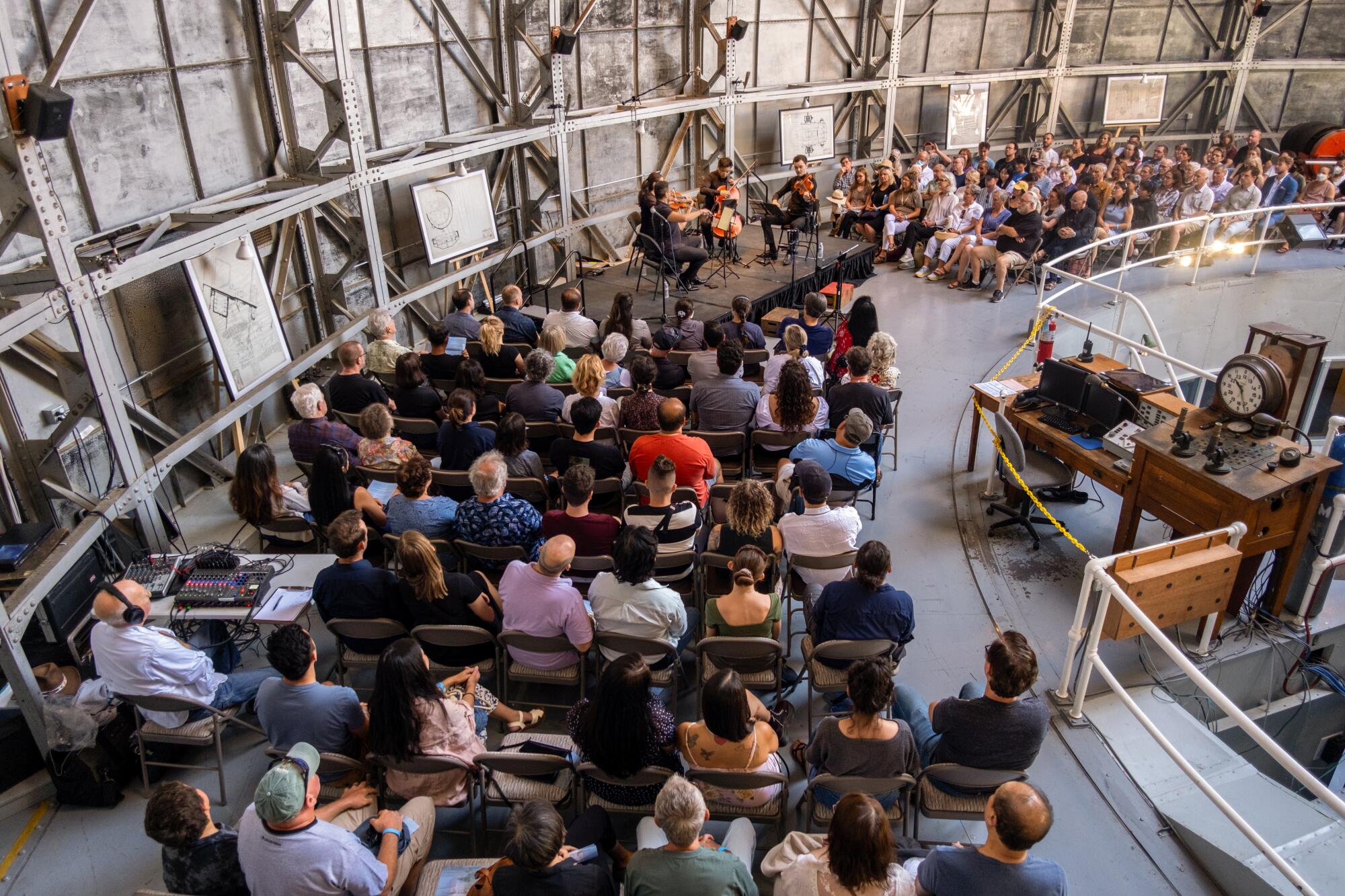
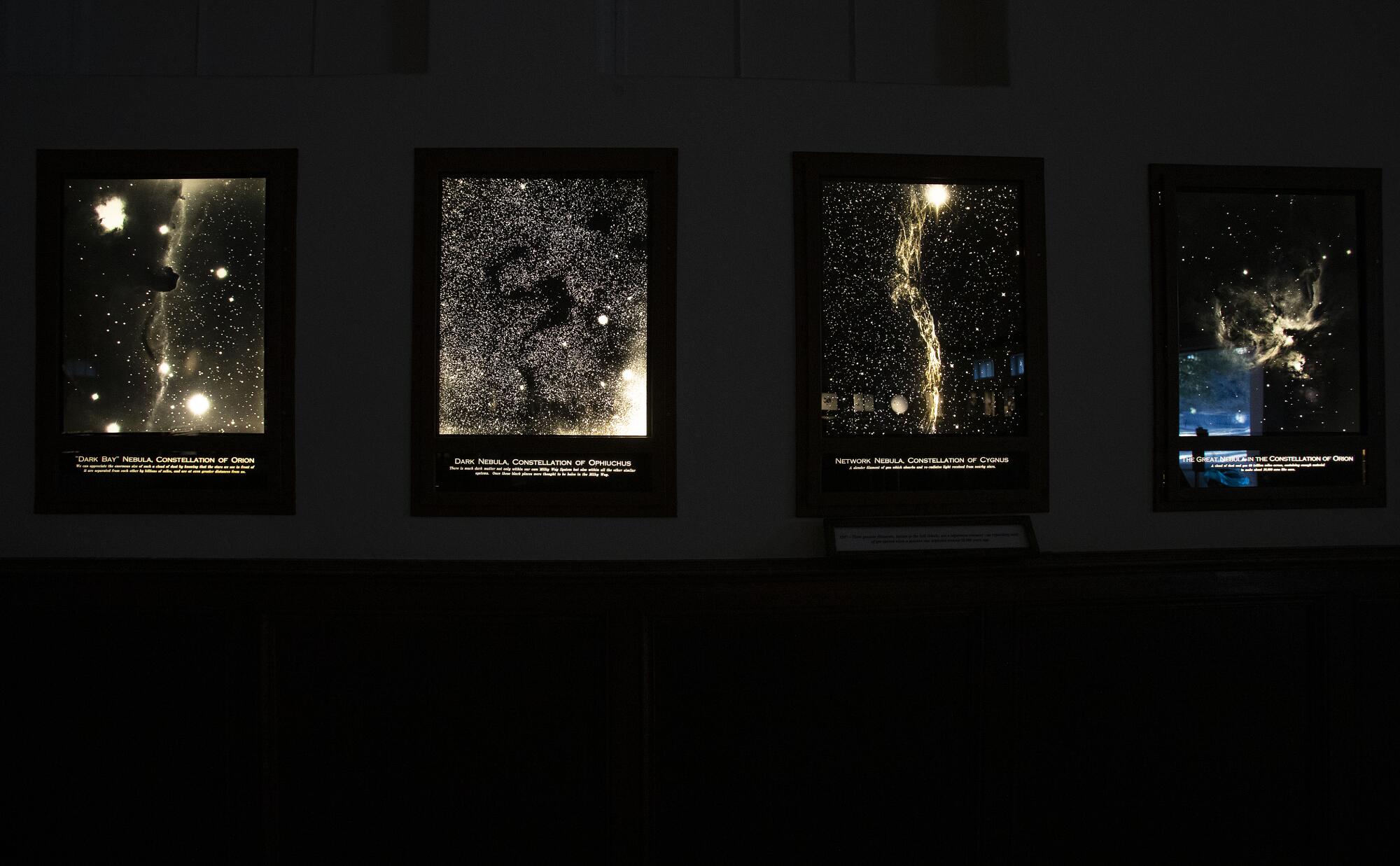
Given the shoestring nature of its operations, they haven’t been able to expand much upon what Carnegie left behind. A small museum is tidy but dated. The text next to an image of Halley’s Comet refers to its 1986 appearance in the future tense. (A framed update from 1997 confirms the flyby happened as scheduled.)
Many institute leaders are coming to grips with the idea that relying almost exclusively on an aging volunteer workforce isn’t the most sustainable long-term strategy.
“The only people who have time to do this are retirees,” said Meneghini, who spends about 60 unpaid hours per week managing personnel, paying bills and doing any odd jobs that need doing.
Maintaining Mt. Wilson, where stuff breaks constantly, is a task in itself. But many volunteers would like to see the observatory offer its visitors more.
It turns out the acoustics in the dome at Mt. Wilson Observatory are extraordinary. On one Sunday each month, the observatory hosts a concert.
In 2021, the institute commissioned architectural drawings of an improved Mt. Wilson Observatory, one that maintains its historic feel with just enough upgrades to ensure that visitors get the most from their visit.
There would be more restrooms, and maybe somewhere to eat besides a kiosk known as the Cosmic Cafe that is open for only a few hours on weekends.
A self-guided walking tour would teach visitors about the achievements that took place there: By a crumbling concrete wall, Albert A. Michelson conducted an experiment that yielded the most precise measurement of the speed of light available at that time. At the 60-inch telescope, Harlow Shapley discovered that our solar system occupied not the galaxy’s hallowed center but a nondescript place in its outer suburbs. Hubble’s observations at the 100-inch telescope revealed that the universe was not only vast, but expanding.
All this takes money. But “to make money, you have to have money,” McAlister said, and the institute does not.
That’s due in part to bad timing. Supporters launched a capital campaign in 2008, just in time for the global financial crisis. They got their events program going around 2015, and then the COVID-19 pandemic decimated ticket sales.
The skill set of Mt. Wilson’s volunteers tends toward engineering and education; fundraising and marketing, less so. The institute attracts people who are far more comfortable talking about stellar parallaxes or maintaining century-old gears than schmoozing with donors or generating buzz.
Although it’s been around longer than a lot of the city’s landmarks, many Angelenos have never heard of the observatory. Others mistakenly believe it closed, or confuse it with Griffith Observatory. (More than one disappointed tourist over the years has made the trek up the mountain only to learn that they’re holding a ticket to an event at the wrong observatory.)
Those who visit Mt. Wilson are often captivated by what they find there. By day, there’s an utterly peaceful stillness. On nights when the telescopes open for public viewing, people line up beneath the gaping maws of the towering domes, awaiting their turn to peer into the cosmos.
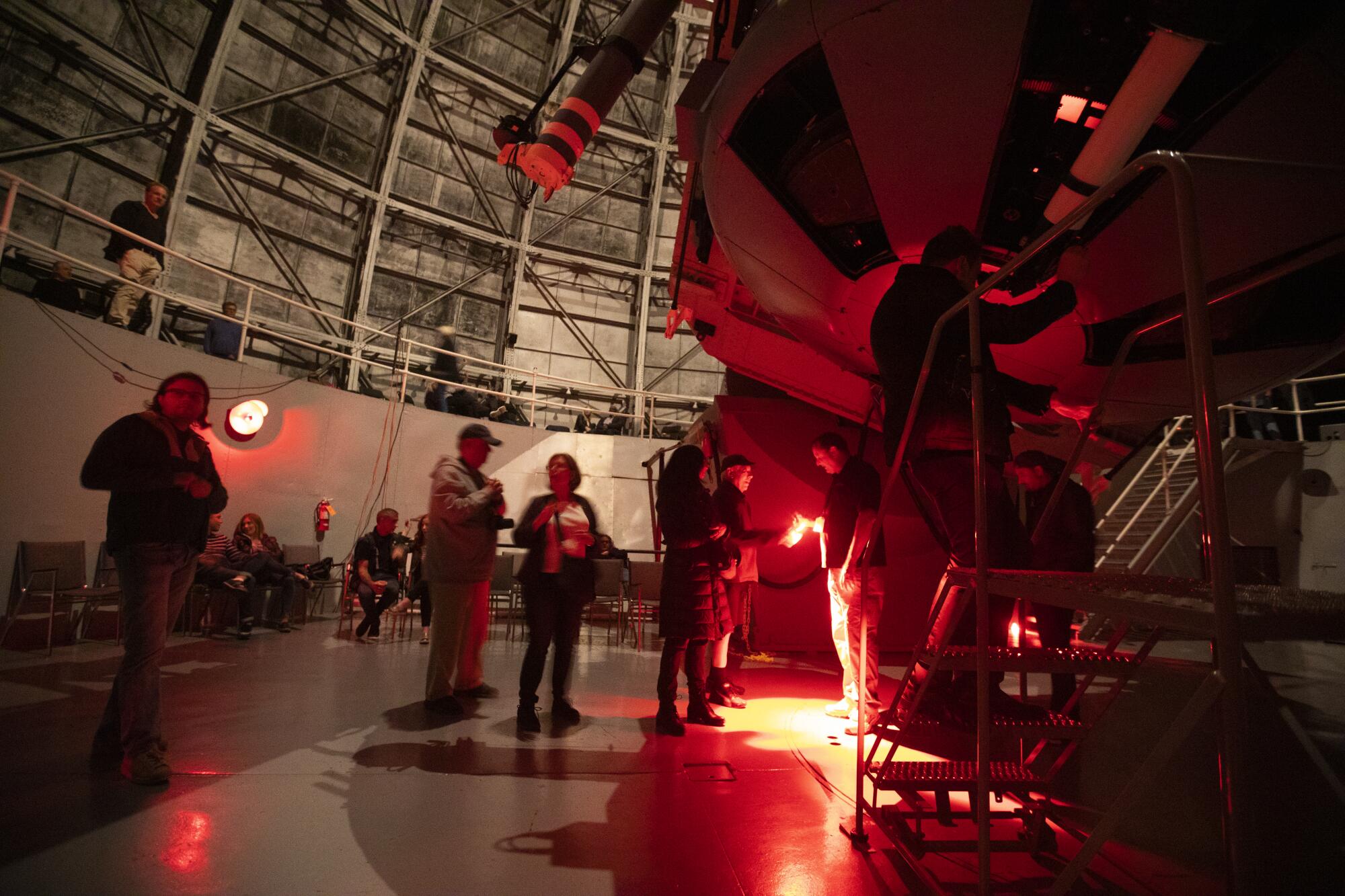
Light pollution has made new discoveries through those telescopes virtually impossible, but the experience of seeing Saturn’s iconic rings or the flare of the Cat’s Eye Nebula is profound, a glimpse into a universe we’ve hardly begun to explore.
“There’s a magic about this mountain,” said Sam Hale, chairman and CEO of the institute and a grandson of the observatory’s founder.
“This is the center of the greatest revelations in modern astronomy ... and so many people don’t even know that this place exists,” he said. “Shame on us that we haven’t gotten more people here.”
Carnegie Science is hosting several events around Los Angeles in honor of the VAR! plate’s centenary, including a fundraiser at its Pasadena building and a public talk with LACMA. But there will be no big event at the observatory. A planned celebration collapsed at the last minute, when a contracted organizer backed out.
Instead, the Mt. Wilson Institute will honor the day as it has every other — by maintaining the place where we found our place in the universe.
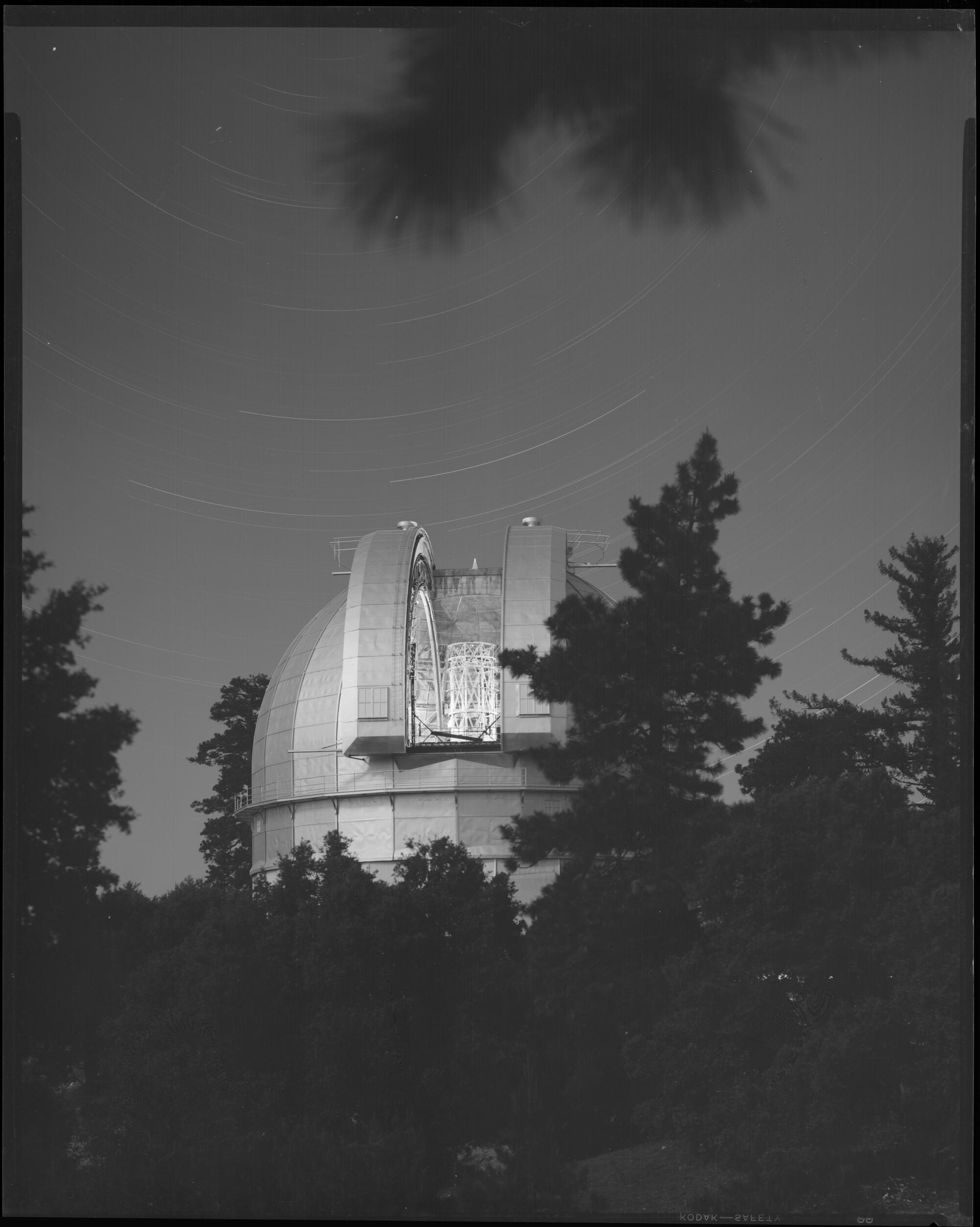
- Share via
Watch L.A. Times Today at 7 p.m. on Spectrum News 1 on Channel 1 or live stream on the Spectrum News App. Palos Verdes Peninsula and Orange County viewers can watch on Cox Systems on channel 99.
